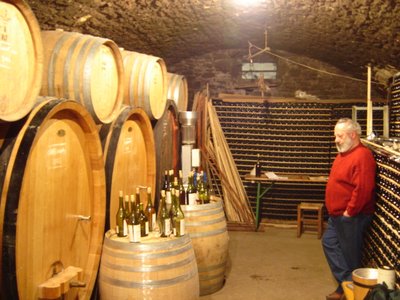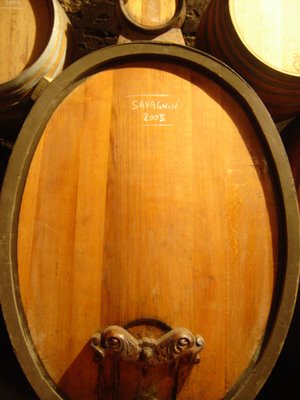Jacques Puffeney Savagnin 2002
Posted on 7 January 2009
Personalité, je chéris ton nom
I delight in the wines of the Jura. Reading randomly through wine blogs and articles, I can see I am not the only one. But Jura’s ascent to recognition has been a slow one. Ten years ago, I think very few foreigners cared about this region, and in France its wines are best described as confidentiels.
Geographically it would be difficult to be more peripheral. Jura occupies a dead point between the back doors of Burgundy and Switzerland. With the former, it shares two of its five grape varieties – Chardonnay and Pinot Noir – as well as its predominantly clay and limestone soils that bear some similarity to those of the Côte de Beaune. With the latter, a firm, semi-Alpine climate where autumns are chilly rather than Burgundian-Indian, resulting in some unique red wines styles that only bear some resemblence to those of Savoie and Neuchâtel, and white wines largely architectured around acidity.
In recent years, delicious budget-priced sparkling wines (Crémant du Jura) and some fascinating mineral-driven Chardonnays have done a lot to spread the region’s name. But I, always looking for vinous oddity, have a profound love for Jura’s speciality, yellow wine – vin jaune – which is a gently oxidised 14% white aged no less than six years in wood, in unfilled barrels, where local strains of yeast grow a thin protective film. This latter technique (called sous voile) inevitably sparks comparisons with fino sherry (or for the well-travelled, szamorodni Tokaj), but whoever has tasted vin jaune knows that its bouquet of curry spice, morel mushrooms and walnuts can be compared to nothing at all.
Vin jaune is made from Savagnin, a grape, like many things in the Jura, grown nowhere else at all – although genetically it is a cousin of the well-known Gewürztraminer. Technically it is Traminer without the gewürz – spice – even though it has plenty. Even when grown without oxidation, Savagnin is easily recognisable for its spicy aromas, as well as it mouth-puckering acidity. In fact, no matter how warm the vintage this grape always manages to taste green and underripe (whence the initial idea of keeping it in barrel for so long, to tame the harsh acids). Although the recent trend in the Jura has been towards a mild ‘internationalisation’ of its wines – planting more Chardonnay, and vinifying Savagnin less oxidatively – and although some of the resulting wines are spectacularly good, I firmly believe Jura’s best calling card are the sous voile wines. Not only vin jaune though – there is plenty of interest and value for money to be found in the lighter examples of oxidative-aged Savagnin.
Here is one from Jacques Puffeney, a Jurassic veteran and one of the region’s most uncompromising producers. Only a quarter of his Savagnin yields vin jaune; the rest is blended with Chardonnay in the delicious Cuvée Sacha or given a shorter period sous voile to produce this wine, simply called Arbois Savagnin.
 Jacques Puffeney in January 2007.
Jacques Puffeney in January 2007.
This is the best photo his badly lit cellar allowed.
2002 was a soft, ripe, classic vintage in the Jura, and this wine can save as a benchmark for Savagnin. It is extremely typical, with notes of garam masala, leavened bread and green apple, followed on the clean palate by outstanding minerality and length. Judging by a certain structural crudeness on end, this is still very young, but I enjoyed it just as much on a cool winter evening with some friends, with some good quality Comté cheese (Jura’s other outstanding agricultural product) someone brought from Paris. This wine really delivers much food for thought and much terroir for its very modic price of 11€.
 Puffeney’s Savagnin stays nearly 4 years in these large foudres.
Puffeney’s Savagnin stays nearly 4 years in these large foudres.

